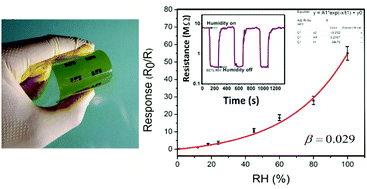A new approach to flexible humidity sensors using graphene quantum dots†
Abstract
Highly sensitive flexible humidity sensors based on graphene quantum dots (GQDs) were developed. The GQDs were prepared using a facile hydrothermal method and characterized considering morphological, structural, and compositional experiments. Then, their humidity sensing properties in correlation with flexibility characteristics were investigated. Good selectivity and response (∼390 for a RH change of 99%), broad detection range (1–100% RH), rather short response and recovery times (12 and 43 s, respectively) as well as flexibility were obtained, demonstrating that the GQD sensors have potential for application in wearable electronics and RH monitoring. Detection of hydrogen (H2) gas by the GQDs confirms the exchange of a proton through adsorbed H+ species in the H2O sensing mechanism. Considering the structure of the sensing material and RT performance, capillary condensation resulting in the formation of a conductive path by water molecules is suggested as the dominant sensing mechanism at high RH.



 Please wait while we load your content...
Please wait while we load your content...